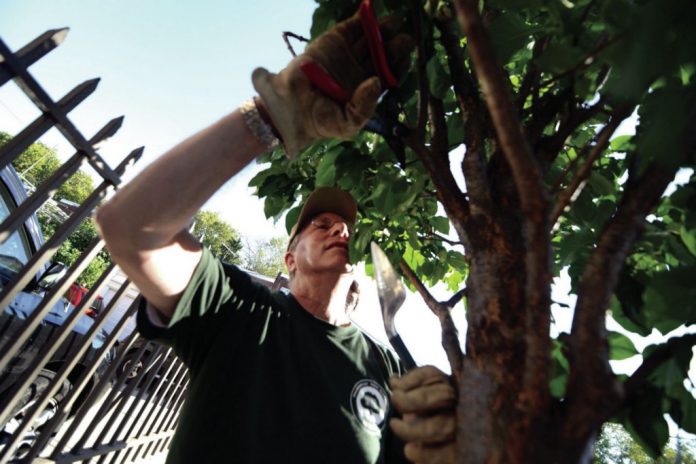Jerome Gabriel, with Northeast Tree Tenders, helps maintain the organization planted in front of the Cottman and Loretto Ave. fire station, Wednesday, July 25, 2012, Philadelphia, Pa. (Maria Pouchnikova)
The members of the non-profit Northeast Tree Tenders have put 530 trees into the ground in the past four years.
But they didn’t just plant ’em and forget ’em. Every year, a small group of members volunteer to revisit the trees to do a little maintenance, said Hasan Malik, the tree tenders’ executive director.
The trees need the attention, he said, as he and other members went to work on five trees outside the firehouse at Cottman and Loretto avenues last Wednesday.
Standing next to a 9-year-old Japanese tree lilac planted four years ago next to the sidewalk on Loretto, Malik showed how to prune it. He carefully trimmed branches that had grown over the sidewalk and into the street where they might brush against cars.
“This tree is good for tight areas,” he said, “but it must be pruned so there is pedestrian and vehicle clearance. We’re not going to let the trees grow like crazy.”
Volunteers clear weeds and cultivate the ground around the trees that were about five years old when they were planted four years ago.
Talking about the dry weather we’ve been having, Malik said watering is really important. Each tree needs at least 15 gallons of water a week to help it develop a good root structure.
To keep moisture in the ground, mulch is needed, but Malik, an arborist, is particular about how mulch should be put down around a tree.
Mulch, or even dirt, should not cover a tree’s flares, the thickened bases of the trunk that shoot out above ground and look like they are anchoring the tree to the ground. He showed how he had mulch put down around a tree in the shape of a doughnut, with the tree rising, untouched by the mulch, through the hole in that doughnut.
Piling up several inches of mulch so that it covers the bottom of the tree trunk is not good for the tree, Malik said, adding it could weaken the tree as it gets older and bigger. Look around and it’s easy to see how often that mistake is made.
One of the main reasons the tree tenders formed is to restore the Northeast’s tree canopy, which has been disappearing.
Member Paul Cohen recalled the tree count was higher when he moved onto the 1400 block of Napfle Street 35 years ago.
“We had 38 trees on my block,” he said. “Now, there’s only one.”
The tree tenders help Northeast residents get trees twice a year and are now accepting applications for street and yard trees for spring 2013. They are planting native redbuds, hawthorns, dogwoods, red maples, honeylocusts, American hornbeams, oaks and lindens.
Go to TreeNortheast.org for an application. E-mail [email protected] or, for those with no Internet access, call Malik at 215–694–9607.
A $20 donation per tree is requested.
The city has a free tree program that is ongoing, but trees from the tree tenders are planted by the organization’s volunteers, not just given to homeowners to plant themselves, and they’re much larger, about 6 feet to 12 feet tall, than the city’s trees. Also, the tree tenders return to check on the trees.
Reporter John Loftus can be reached at 215–354–3110 or [email protected]
Tending to the trees
The Northeast Tree Tenders will be pruning trees they planted in the Northeast throughout the month of August.
Volunteers are welcome to help out at the following locations:
Lawncrest, 6:30 p.m. on Aug. 1, at Rising Sun and Cottman avenues;
Rhawnhurst, 6:30 p.m. on Aug. 8, Loney and Frontenac streets;
Fox Chase, 6:30 p.m. on Aug. 15, Palmetto and Stanwood streets;
Somerton, 6:30 p.m. on Aug. 22, Boyle Recreation Center, 13024 Stevens Road.
The addresses above are where the volunteers meet, then they move to different locations to tend to trees at other sites.





